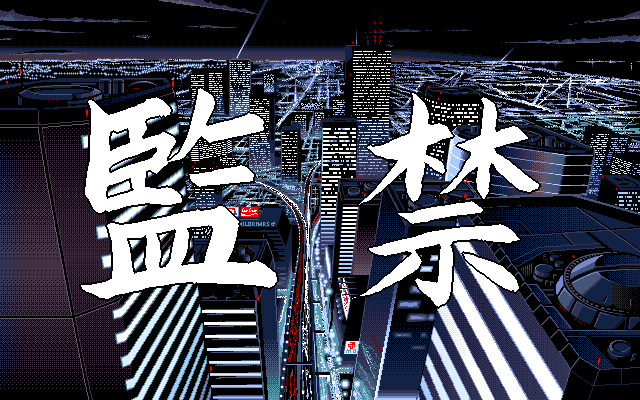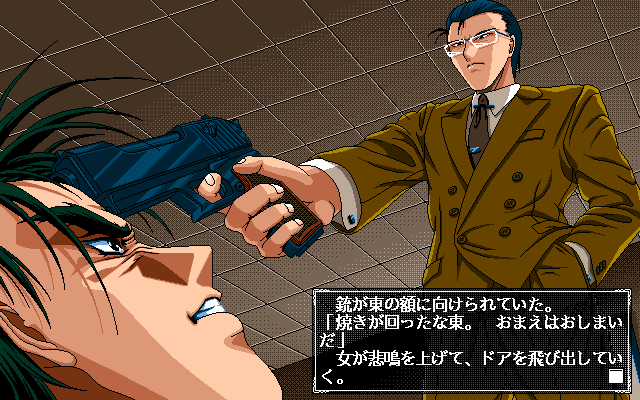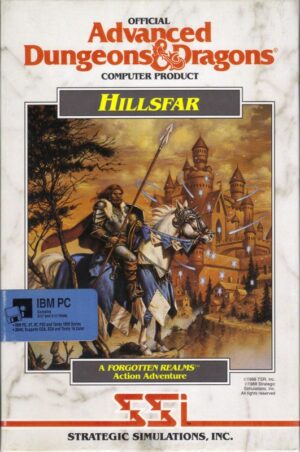Retro Replay Review
Gameplay
Kankin dispenses with traditional exploration or action sequences, instead relying almost entirely on menu‐driven choices. At each juncture the player is presented with a handful of options—investigate, question, resist, or comply—but there is no on‐screen avatar to move or environments to navigate. This minimal interactivity can feel restrictive, especially for players accustomed to watching a character walk through futuristic streets or engage in real‐time combat.
(HEY YOU!! We hope you enjoy! We try not to run ads. So basically, this is a very expensive hobby running this site. Please consider joining us for updates, forums, and more. Network w/ us to make some cash or friends while retro gaming, and you can win some free retro games for posting. Okay, carry on 👍)
The illusion of agency is further challenged by the game’s trial‐and‐error approach to progression. Wrong choices occasionally trigger an abrupt Game Over, sending you back to the last decision point. More often, however, you simply have to cycle through every option multiple times until the story allows you to advance. While this loop can pad playtime, it can also break immersion, turning tense narrative beats into repetitive button‐mashing exercises.
For those who enjoy branching narratives and multiple endings, Kankin offers a modest appeal. Each decision branches the plot slightly, and discovering every variation requires patience. Yet fans of Illusion’s earlier works, such as Mokkoriman RPG, may find the lack of traditional RPG mechanics or any form of character movement a startling departure. If you’re willing to embrace a stripped‐down, choice‐based format in exchange for a gritty storyline, Kankin’s gameplay will be intriguing. Otherwise, the game may feel too static to sustain long‐term engagement.
Graphics
Visually, Kankin leans into a stark, cyberpunk aesthetic. Backgrounds depict sprawling cityscapes of Koube City at night, illuminated by neon signs and shrouded in perpetual rainfall. These static illustrations capture the oppressive atmosphere of 2197’s urbanized Japan, where concrete towers blot out the sun and crime festers in shadowy alleyways.
Character portraits are rendered in sharp detail, with distinct color palettes that help differentiate Sagoto, Kikuno, and Chisame. Facial expressions shift subtly to convey fear, defiance, or despair as the plot unfolds. However, all visuals remain two‐dimensional and unanimated, meaning cutscenes rely on still images and text rather than dynamic sequences or voice‐overs.
While Kankin’s art direction effectively establishes its dark world, the lack of animation and limited scene transitions can make the presentation feel dated—even by early 2000s adventure standards. If you appreciate high‐contrast lighting, moody color schemes, and moody concept art, the graphics will hold some appeal. But if you expect fluid character movement or ambient environmental effects, you may find the visuals disappointingly static.
Story
The narrative opens in the year 2197, as Japan has been transformed into an endless urban sprawl to compete with global superpowers. Koube City is an expanse of soulless high‐rises and neon‐lit streets, where crime and violence are as commonplace as the monorails that crisscross the skyline. Into this world we are introduced to three female police agents—Sagoto, Kikuno, and Chisame—tasked with dismantling a powerful drug ring.
From the very first scene, Kankin subverts expectations. What begins as a straightforward undercover operation quickly spirals into a nightmare: our heroines are ambushed, captured, and subjected to unspeakable cruelty by ruthless criminals. The story alternates between their perspectives and those of minor characters, building a fragmented but harrowing account of survival and desperation.
While the plot’s pacing can feel uneven—interlaced with repetitive decision loops—the core storyline is undeniably dark and immersive. The game explores themes of powerlessness in a hyperurbanized society, the moral complexities of law enforcement under extreme duress, and the lengths people will go to retain dignity when all hope seems lost. For players drawn to mature, psychologically intense narratives, Kankin offers a narrative that lingers long after the final scene fades to black.
Overall Experience
Kankin is a niche title that will resonate most with fans of dark, story‐driven Japanese adventures and those curious about the fringes of interactive fiction. Its stripped‐down gameplay and limited interactivity may alienate players expecting a traditional RPG or point‐and‐click adventure. Yet its uncompromising narrative and brooding cyberpunk setting provide a unique, if challenging, experience.
Technical limitations—static backgrounds, still portraits, and menu‐only input—underscore the game’s indie roots and budgetary constraints. Still, the artistry in its environments and character designs demonstrates a clear vision: to immerse players in a dystopian world where technology and crime have metastasized unchecked. If you prize atmosphere and story over flashy mechanics, you’ll find Kankin’s visuals and narrative design compelling.
Ultimately, Kankin demands patience and a willingness to embrace its repetitive decision‐making loops. When it clicks, you’ll be captivated by the tension of Sagoto, Kikuno, and Chisame’s plight. When it falters, the gameplay loop can feel like a chore. For those seeking a truly dark, Japanese‐style visual novel with minimal player agency but maximum narrative intensity, Kankin is a worthwhile, if imperfect, journey into the heart of dystopian despair.
 Retro Replay Retro Replay gaming reviews, news, emulation, geek stuff and more!
Retro Replay Retro Replay gaming reviews, news, emulation, geek stuff and more!









Reviews
There are no reviews yet.